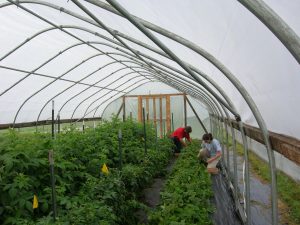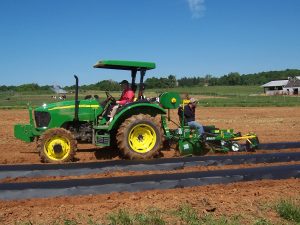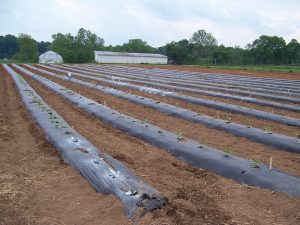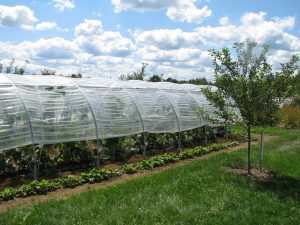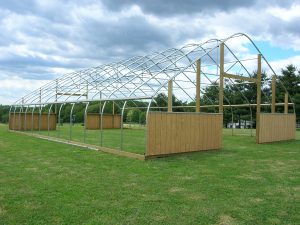Bulletin #1022, Maine Season Extension Options: Making the Right Choice for Your Farm
By Caragh B. Fitzgerald, Assistant Extension Professor, University of Maine
For information about UMaine Extension programs and resources, visit extension.umaine.edu.
Find more of our publications and books at extension.umaine.edu/publications/.
Table of Contents:
- Finding a Good Fit for Your Operation
- Techniques
- Estimated Costs of Various Season Extension Techniques
- Choosing Your Season Extension Method
- Resources
Season extension techniques allow you to grow your products for longer than they can be grown under typical field conditions in your area. In the Northeast, these techniques focus on getting a crop to produce earlier or continue later in the season. Some techniques also allow for a winter harvest of cool-season crops. Direct benefits of season extension include
- getting a product to market earlier, when prices are higher,
- being able to harvest a warm-season crop that typically performs inconsistently due to cool weather, and
- having a longer harvest period overall.
Other benefits may include a reduction in weather, pest, and disease damage, lower pest-control costs, and improved quality.
There are many options available to enable produce growers to extend their growing seasons. As with most farm activities, success or failure will depend on the material, management, and implementation details. We have provided a list of resources at the end of this bulletin to help you research these details. Other farmers, Cooperative Extension personnel, consultants, and vendors can also be valuable resources to help with your decision-making.
Finding a Good Fit for Your Operation
How do you decide what, if any, season extension methods are the best for you? You can test inexpensive techniques on a small scale with little risk beyond time, energy, some plant material, and a little bit of money. But before investing in a costly alternative such as a high tunnel or a greenhouse, you should carefully weigh the value of the technology and its costs.
First, decide what you want to achieve. Then, consider the following questions:
- What new crops do you want to grow, or which ones do you want to grow differently? Be sure there is a market for these products. Don’t skip number 4.
- When will you be growing? Some high tunnels and greenhouses are designed to withstand or shed a winter’s snow load. However, such rugged structures are much more expensive per square foot than row cover and/or plastic over low tunnels or caterpillar tunnels. If you aren’t growing or harvesting crops when there is likely to be snow, then you can use a less sturdy—and less expensive—structure.
- When will the new market season be? It is easier to add a product to an existing market outlet than it is to develop a new market or buyers.
- What price can you charge for your products? Will you be able to recoup the higher cost of production incurred by using season extension technology? When evaluating a potential season extension technique, keep in mind that there can be benefits that are hard to calculate. For example, some items without high-profit margins can draw customers to your farm stand and increase overall income.
- What will you need in order to implement this technology successfully? Will you need irrigation under the plastic mulch? Time and equipment to bend hoops for low tunnels? Labor and equipment for high tunnel construction? Sometimes farmers (and others) purchase new equipment with the best of intentions, only to find out that they don’t have the time to install it or to learn how to use it effectively.
- Can your farm accommodate something new now? New methods can create a mental and emotional drain as you learn how to implement them. They may take personnel or funds away from other parts of the farm, perhaps leaving those areas critically unsupported. Field and pest management activities will be different. Structures may need frequent monitoring, even multiple times a day. Yield reductions or crop losses are possible if temperatures get too high or if high winds destroy a structure. This is especially true for those structures that are passively ventilated. While none of these demands are necessarily deal-breakers, it is important to keep these points in mind. Significant new undertakings can move a business forward, but they can also strain an already-struggling business.
Before you invest heavily in season extension methods, consider:
- what you want to achieve,
- where you will sell your products,
- the price you need to charge,
- the time, money, labor, and technology requirements, and how they will affect other aspects of your farm.
Techniques
No-cost or very low-cost options
Some methods of season extension are free or very inexpensive and require little or no equipment. These include:
- Field selection. Take advantage of southern-sloping fields that warm fastest in the spring. Avoid planting your earliest, most tender crops in low areas, since this is where the cold air will collect. Soil that dries out quickly will warm faster than a heavy, wet, high-clay soil.
- Variety selection and planting dates. Choose varieties that are more heat- or cold-tolerant to extend the harvest season. Many seed catalogs now recommend certain varieties for season extension or for growing in high tunnels. Succession planting can also ensure harvestable product later in the season.
- Transplants. Use transplants (for crops that grow well from transplants) to give you a head start on the season. By the time the soil and weather warms sufficiently for outdoor growth, you will be setting out a small plant, not a seed.
- Wind breaks. Wind breaks can create small areas with warmer growing conditions. Small grains, perennial grasses, trees, or a fence may help to block crops from early-season winds. Be sure that the wind break is high enough to be effective, and that it does not shade the crop or compete for water or nutrients.
- Raised beds. Soil in raised beds will dry and warm faster than soil that is flat in the field. Home gardeners often use frames to contain the soil of their raised beds, but no-frame raised beds are more practical for commercial production. Bed heights of six to eight inches are common.
Options that require some investment
Mulch
Plastic mulch products are used to cover planting beds in order to raise the temperature of the soil beneath them. Much of the temperature increase occurs when the plastic is in direct contact with the soil, so it is important that the plastic is laid tightly against the soil. Plantings are made via holes cut in the plastic. Plastic mulches conserve water, but many growers, especially those on sandy soils, will use trickle irrigation under the plastic to provide adequate moisture.
- Black plastic mulch suppresses weed growth and raises daytime soil temperature. Compared to bare soil, soil under black plastic will be about five degrees warmer at two inches deep, and three degrees warmer at four inches deep.1
- IRT (infrared-transmitting) plastic raises soil temperatures more than black plastic. It also transmits more light, so weed suppression is reduced.
- Reflective mulches have been shown to increase pepper and tomato yield in Maine. Blue or red mulches may increase pepper and tomato yield, but not necessarily enough to cover the cost of the mulch.
- Biodegradable mulches are also available. They tend to be more expensive, but recent research shows that some types provide a degree of soil-warming and weed-suppression similar to that of black plastic. For more information about biodegradable mulches, see New England Vegetable and Fruit 2011 Conference Proceedings. (https://newenglandvfc.org/past-conference-proceedings-presentations/2011-proceedings)
- Straw or newspaper mulches will not warm the soil, but in fact, will keep it cooler than if the ground were bare. However, they are good at conserving soil moisture, and they can help suppress weeds.
Row cover
Row cover is translucent spunbonded material that protects plants while allowing light and water to pass through. The lighter weights of this material are often used as physical barriers to insects. Heavier weights of the material will keep the temperature of the enclosed area elevated. These materials can be applied in long, narrow rows to cover one or two beds, or they can be used in large sheets. It is important to secure the edges, or else the row cover will blow away.
The thicker the row cover is, the more heat it will retain, and the less light it will transmit. So you will need to strike a balance between heat retention and light. If you use heavy-weight materials, you may have to lift the sides so that temperatures don’t get too high for the plants underneath.
The lighter-weight materials can be laid directly on most plants without support. Some plants, such as eggplant and pepper, have sensitive growing points, though, which may be damaged without support.
Plastic cover
A clear plastic cover is even more effective at raising and retaining heat than row cover. But it does not allow any water in, and plants can be “cooked” if the enclosure is not vented. Venting by lifting or removing plastic by hand can be time-consuming, so some farmers use slitted or perforated plastic covers. When temperatures are cold, the slits remain mostly closed. When temperatures under the plastic increase, the hot air rises through the pre-cut slits in the plastic. Plastic covers are often supported using low hoops (see below).
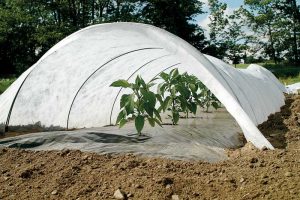
If plastic is being used to keep frost off the plants, it must not be allowed to touch them, or the foliage touching the plastic may be damaged by the cold.
Low tunnel
Low tunnels are structures built from short (usually less than three feet high) arched supports that hold plastic or row cover above the plants. The cover can then be used to protect the plants from frost since the material is not touching the plants. The supports will prevent any potential distortion in plant growth from contact with the cover. The cover still needs to be secured on the ground. The capacity for low tunnels to withstand winter snow depends on the material used for the tunnel supports, the spacing of these supports, and your area’s snow load. Again, low tunnels using a plastic cover or heavy-weight row cover may need to be vented by raising the sides or ends to keep the crops from getting too hot.
Walk-in or caterpillar tunnel
Walk-in or caterpillar tunnels use taller hoop-style supports. These tunnels are typically between eight and eighteen feet wide, around six feet or taller, and twenty-four to three hundred feet long. The cover (plastic or row cover) is held up by the supports, which may be connected by a central ridge pole that runs beneath the tops of the hoops. The cover is secured by ropes that are pulled over the cover from one side to the other and pinned by anchors at the sides (picture a pioneer covered wagon). Ventilation, which is necessary to keep crops from overheating, is achieved by pushing the cover-up along the sides. Friction keeps the cover-up, although sometimes clamps or other techniques are needed. The ends of the plastic are usually secured by winding the plastic around a stake at the end of the tunnel and tying it in place. The type and spacing of supports will influence a caterpillar tunnel’s capacity to withstand high winds and winter snows.
High tunnel or hoophouse
High tunnels (also known as hoophouses) were originally envisioned as low-cost alternatives to greenhouses. They consist of hoop-style supports covered with plastic. The structures are tall, typically six feet or higher at the center. Compared to caterpillar tunnels, high tunnels usually have more internal supports and bracing along their length, making them stronger structures. The plastic is secured along the sides and ends, reducing air leakage, and is attached in such a way that the sides can be either rolled up or dropped down for ventilation. High tunnels are also usually constructed with doors, making winter access easier. High tunnels protect crops from some of the season’s later or earlier frosts. They are often used to enhance the production of warm-season crops, as well as to grow and hold cool-season crops for winter harvest—as detailed in Eliot Coleman’s book, Four-Season Harvest. Many of these structures have no heat or electricity. This is a highly adaptable type of structure, though, and farmers have designed modifications by using a variety of materials, adding supplemental heat sources, and using fans for supplemental ventilation. You can also include other season extension techniques in a high tunnel, such as plastic mulch, row covers, or low tunnels.
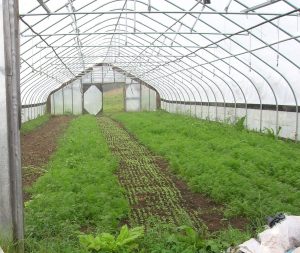
In Maine, winter snow weight is a very serious concern for high tunnel owners. Some designs — for example, Gothic instead of Quonset — and materials — such as galvanized pipe instead of PVC pipe — are better than others at withstanding the weight of winter snow. You can remove the plastic covering on weaker tunnels in the fall to eliminate the possibility of collapse. Alternatively, you can roll the plastic up to the peak of the house and secure it there.
Although high tunnels were originally designed to be unheated, some farmers have installed supplemental heat. Techniques range from a wood or corn stove to in-ground heat provided by propane, waste vegetable oil, or solar hot water. If you are considering adding supplemental heat, first carefully evaluate the economic benefit you hope to gain and the cost of the system. Then, watch your crops carefully to be sure that you don’t create other production problems with your heat source.
Conventional greenhouse
As opposed to some of the techniques discussed above, which may be described as low-input greenhouses, a conventional greenhouse has electricity and heat. Vents and large fans are used, and electric lights may supplement natural light. Heat, often provided by one or more furnaces, may be used regularly in late winter, spring, and fall, rather than just on a supplemental basis. A variety of watering systems may be in place. In some cases, the heating, lighting, and watering systems are at least partially automated. Production usually occurs in flats or pots on tables or benches, rather than in the ground. In fact, the floor of a greenhouse is often concrete, or at least covered with landscape fabric. With a conventional greenhouse, you can grow plants far beyond their typical production period. Plant growth in a greenhouse is rapid. However, pest development can also be rapid.
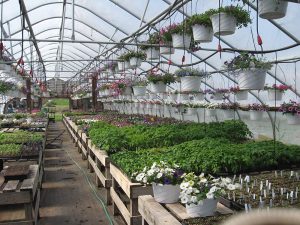
Because of the cost of materials and equipment, a conventional greenhouse is expensive to set up and maintain. Carefully evaluate the needs of your crops to be certain a conventional greenhouse is warranted. You should also develop a good marketing and business plan.
There are many greenhouse styles, materials (supports and covering), benches, heat sources, lighting, and ventilation options to consider. Consult the references at the end of this article for more specific information and links.
There have been a number of case studies written about heating options for Vermont greenhouses that are applicable to Maine. See the Energy Information for Vegetable and Berry Growers page (http://www.uvm.edu/vtvegandberry/energylinks.html) on the University of Vermont Extension website for these reports.
Estimated Costs of Various Season Extension Techniques
The following estimates2 are provided for general planning purposes only. Actual costs are extremely variable, and depend on specific materials, amounts, or sizes purchased and used, as well as labor. Do your research!
$ Plastic mulch, row cover, plastic cover, low tunnel: up to $0.10 per square foot of cover materials
Additional costs are likely for trickle irrigation, supports, staples or pins to secure material, etc. When planning, remember that the amount of row cover or plastic cover needed will generally be greater than the square footage covered, since the material will be raised over plants or supports.
$$ Walk-in tunnel: up to $0.50 per square foot of covered area
$$$ High tunnel: up to $1.00–$3.00 (or more) per square foot of covered area
$$$$ Conventional greenhouse: $3.00–$10.00 (or more) per square foot of covered area
Choosing Your Season Extension Method
There are a variety of techniques that can help you extend your production or harvest season, allowing you to increase the number of products you sell and/or the period for which they are available. Your choice of technique(s) will depend on what you want to achieve, the markets available to you, the price you can charge, the requirements of the technology, and your ability to incorporate something new. Many farmers have found these techniques to be important to their overall profitability. Careful research, experimentation, and record-keeping will tell you whether one or more is a good fit for you.
Resources
Publications
Season Extension Techniques for Market Gardeners
Janet Bachman (2005). Butte, MT: ATTRA/NCAT. 800-346-9140
Outlines cultural practices, plasticulture, and economics of season extension. 42 pages.
High Tunnels: Using Low-Cost Technology to Increase Yields, Improve Quality, and Extend The Season
Ted Blomgren and Tracy Frisch (2007). Burlington: University of Vermont Center for Sustainable Agriculture.
Focuses on high tunnels, but also includes information on walk-in tunnels and low tunnels. Sections on marketing, site considerations, selecting a structure, construction tips, environmental management, soil and crop management, and pest management. Six case studies, 77 pages. (See companion video under “Videos” below.)
Starting in The Greenhouse Business
Will Healy, James Hanson, and Stanton Gill. (1998). College Park: Maryland Cooperative Extension, Fact sheet 593
Includes lists of crops; outlines types of production, site selection, costs of construction (1990 prices). 8 pages. http://extension.umd.edu/publications/pdfs/fs593.pdf
Construction of High Tunnels: Resources for Organic Farmers
Kristin Pool and Alex Stone (2012). eOrganic/eXtension article. Brief article and links.
Season Extension: Introduction and Basic Principles
Debbie Roos and Doug Jones. (2012) Pittsboro: North Carolina Cooperative Extension
Describes the mechanisms of season extension as well as cultural practices, fabrics, and structures. 16 pages.
Books
High Tunnel Production Manual, 2nd Edition
The Pennsylvania State University (2003). University Park: The Pennsylvania State University.
Covers construction and maintenance, planting, irrigation, environment, pest management, nutrient management, mulching, crop production (vegetable, berry, cut flower, sweet cherry), economics, marketing, organic methods, heating with waste plastics.
The Hoophouse Handbook: Growing Produce and Flowers in Hoophouses and High Tunnels, 2nd Edition
Lynn Byczynski, ed. (2009). Lawrence, KS: Growing for Market
Farmer experiences, materials, design, construction.
The Winter Harvest Handbook
Eliot Coleman (2009) White River Jct, VT: Chelsea Green
Schedules, “cold” and “cool” greenhouses, crop types, greenhouse design, cropping methods, pests, marketing, economics, and tools.
Four-Season Harvest: Organic Vegetables from Your Home Garden All Year Long
Eliot Coleman (1992). White River Jct., VT: Chelsea Green
Written for home gardeners, but includes useful information about cold frames and mobile high tunnels, as well as planting schedules.
Videos
High Tunnels: Using Low-Cost Technology to Increase Yields, Improve Quality, and Extend the Season, DVD
Ted Blomgren and Tracy Frish, producers. Burlington: University of Vermont Center for Sustainable Agriculture.
43-minute video features six farms in five northeastern states.
Websites
Cornell High Tunnels. Cornell University information about structures, crops, business, and marketing.
Energy Information for Vegetable and Berry Growers. University of Vermont Extension information includes case studies of greenhouse heating options.
Greenhouse Management. UMass Extension’s Greenhouse Crops and Floriculture Program resources
Hightunnels.org. Information for educators and growers from K-State Research and Extension, University of Missouri Extension, and University of Nebraska Cooperative Extension.
The Pennsylvania State Center for Plasticulture. Pennsylvania State University information about crops, plastic mulches, high tunnels, and low tunnels.
Special thanks to the following reviewers:
- Associate Extension Professor Mark Hutchinson, University of Maine Cooperative Extension
- Extension Professor Richard Kersbergen, University of Maine Cooperative Extension
1 Douglas C. Sanders, Using Plastic Mulches and Drip Irrigation for Vegetable Production (Raleigh: North Carolina Cooperative Extension Service, 2001), accessed August 23, 2012, http://www.ces.ncsu.edu/depts/hort/hil/hil-33.html.
2 Values obtained from: commercial suppliers (January 2011), Ted Blomgren and Tracy Frisch, High Tunnels (Burlington: University of Vermont Center for Sustainable Agriculture, 2007), and Lane Greer and Steve Diver, Organic Greenhouse Vegetable Production (Fayetteville, AR: ATTRA, 2000), accessed August 27, 2012, http://attra.org/attra-pub/ghveg.html.
Originally produced with funding support from

and in cooperation with


Information in this publication is provided purely for educational purposes. No responsibility is assumed for any problems associated with the use of products or services mentioned. No endorsement of products or companies is intended, nor is criticism of unnamed products or companies implied.
© 2012
Call 800.287.0274 (in Maine), or 207.581.3188, for information on publications and program offerings from University of Maine Cooperative Extension, or visit extension.umaine.edu.
In complying with the letter and spirit of applicable laws and pursuing its own goals of diversity, the University of Maine System does not discriminate on the grounds of race, color, religion, sex, sexual orientation, transgender status, gender, gender identity or expression, ethnicity, national origin, citizenship status, familial status, ancestry, age, disability physical or mental, genetic information, or veterans or military status in employment, education, and all other programs and activities. The University provides reasonable accommodations to qualified individuals with disabilities upon request. The following person has been designated to handle inquiries regarding non-discrimination policies: Director of Institutional Equity and Title IX Services, 5713 Chadbourne Hall, Room 412, University of Maine, Orono, ME 04469-5713, 207.581.1226, TTY 711 (Maine Relay System).


